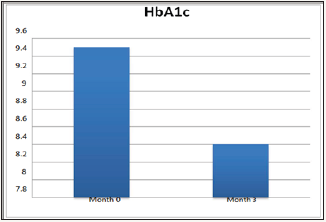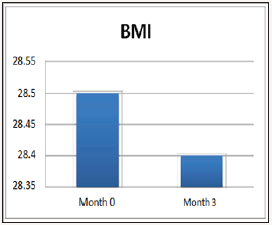- Submissions

Full Text
Intervention in Obesity & Diabetes
Remote Monitoring Improves Diabetes Control in Urban Indian Population within 3 Months
Thara Murali*
Department of Diet and Nutrition, Diabetacare, Bangalore, India
*Corresponding author: Thara Murali, Chief Dietician/General Manager Clinical Services, Department Of Diet n Nutrition, Diabetacare, Bangalore
Submission: March 14, 2018;Published: April 19, 2018

ISSN 2578-0263
Volume1 Issue3
Introduction
The aim of this study was to compare change in HbA1c and anthropometric measurement in subjects who have accepted remote monitoring for their diabetes management
Subject and methods
a. Diabetes subjects who accepted remote monitoring
b. Patients completing 3 months follow up and had paired data
c. Comparison were made between initial HbA1c and that after 3 months using paired t test
d. BMI and waist circumference
Results
a. Total no of patients = 56
b. Mean age 53.4 +/- 12.7 years
c. Male: Female = 28:28
d. All had paired observation 3 months apart
e. Significant reduction in HbA1c from 9.5% to 8.4% [Figure 1]
Figure 1: Reduction in HbA1c from 9.5% to 8.4%.

f. Statistically non-significant reduction in Waist circumference & BMI [Figure 2 & 3]
Figure 2: Statistically non-significant reduction in waist circumference.

Figure 3: Statistically non-significant reduction in BMI.

Discussion
Remote monitoring can be successfully used to improve diabetes control in patients with diabetes.
There was no effect on BMI or waist circumference possibly due to short duration
Long term data will be needed which we are collecting now
Conclusion
Advantages of remote monitoring for
Patients: Do not have to come to clinic, have friendly advice 24/7,
Doctors: Not disturbed during their busy hours at work or home, have access to all data at smart phone via App [Tables 1-3],
Total no of patients = 56
Mean age 53.4 +/- 12.7 years
Male: Female = 28:28
All had paired observation 3 months apart
Table 1:

Table 2:

Table 3:

Modern technology can be a useful tool for providing effective management of diabetes when used with appropriate clinical support. However, its use in Indian setting has not been established. We have introduced telemedicine in our clinic in Bangalore, where patient’s blood sugar, blood pressure and dietary intake can be monitored and appropriate advice can be given by clinicians by telephone. We wanted to study if such intervention can demonstrate objective difference.
Aim
The aim of this study was to compare change in HbA1c and anthropometric measurement in subjects who have accepted remote monitoring for their diabetes management.
Subject and methods
Diabetes subjects who accepted remote monitoring were studied. Only those subjects who had completed 3 months follow up and had paired data were studied. Comparisons were made between initial HbA1c and that after 3 months using paired t test. Similar comparisons were also made in BMI and waist circumference. There were not enough data to compare lipid profiles so it was not analysed.
Results
56 subjects (28 males) with mean age of 53.4 (+/- 12.7) years had accepted remote monitoring and completed 3 months of follow up check up. There was a significant reduction in HbA1c at 3 months follow up (9.5 +/- 2.2% vs 8.4 +/- 1.8%; p = 0.0002) with remote monitoring. 41 subjects had reduction in HbA1c, however 15 in subjects it increased within 3 months. There was no difference in BMI or waist circumference during this time.
Discussion
Our results show that remote monitoring can be successfully used to improve diabetes control in subjects with diabetes. There was no effect on BMI or waist circumference as the duration might have been short. Long term data will be needed to demonstrate its efficacy in improving overall diabetes management.
© 2018 Thara Murali. This is an open access article distributed under the terms of the Creative Commons Attribution License , which permits unrestricted use, distribution, and build upon your work non-commercially.
 a Creative Commons Attribution 4.0 International License. Based on a work at www.crimsonpublishers.com.
Best viewed in
a Creative Commons Attribution 4.0 International License. Based on a work at www.crimsonpublishers.com.
Best viewed in 







.jpg)






























 Editorial Board Registrations
Editorial Board Registrations Submit your Article
Submit your Article Refer a Friend
Refer a Friend Advertise With Us
Advertise With Us
.jpg)






.jpg)














.bmp)
.jpg)
.png)
.jpg)










.jpg)






.png)

.png)



.png)






